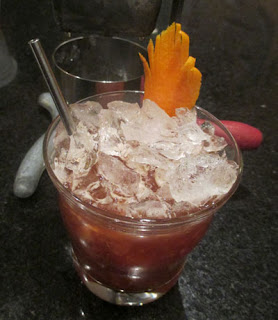
I just finished reading Alex Liddell's
Madeira: The Mid-Atlantic Wine and wanted to make a list of the salient ideas in the book as a reference for myself and others. Besides having a love of madeira in
cocktails, the restaurant I work in, Loyal Nine, has an interest in madeira due to the wine's Colonial history and thus we offer flights of the four noble varieties. While there are a lot of common table wines grown on the island, most of the interest is focused on the aged and fortified variety. At first, the wines produced a high enough acidity and alcohol content on their own to make it over on the hot, spoil-inducing voyage to the American colonies, but later fortification with distilled spirits became the norm starting around the 1750s. British restriction on the American colonies made madeira rather popular; the British banned all European products unless they were brought over on British ships leaving British ports. Madeira, however, despite being under Portuguese control, is an island closer to the shores of Africa than Europe and was exempt from these restrictions. More modern madeira production mimics the long, expensive process of being kept in hot ships' holds through heating the wine via a process called estufagem. Whether modern steam-jacketed heated tanks or more classical casks left in hot parts of buildings, this cooking process converts the wine into something almost unspoilable and capable of long aging. Like centuries long. In fact, the author includes his tasting notes on late 18th century madeiras that were often spectacular (although some had crashed over the years due to poor storage or other issues).
Notes on the four noble varieties of madeira from driest to sweetest:
 Sercial
Sercial
• Grape variety known on the Portuguese mainland as
Esgano Cão or the "dog strangler" due to its "mouth-puckering, astringent acidity."
• Grows at high altitude, difficult to grow, only limited sites.
• Palest and driest of noble madeiras.
• Younger versions have orange and dried fruit notes. Nuttiness develops with maturity. With longer aging, flavors can fade but develop balsamic qualities.
• Great palate cleanser due to its high acidity.
Verdelho
• Different from Verdelho in Portugal but the same as the one from the Azores.
• Capable of growing in harsher environments and moderately high altitudes. Prefers to grow close to the sea.
• Slightly darker and sweeter than Sercial. Less brusque as well.
• Younger versions have honeyed, slightly chocolate, and candied citrus notes. Aging intensifies flavors.
• Great to be drank all through the day as acidity is balanced by a hint of sweetness. As an aperitif and with food as well.
Boal
• Grows at low altitudes on the south half of the island.
• Low yields but the grapes are compact bunches of small, sugar-laden grapes.
• Darkest grape of the four.
• Younger versions have a barley sugar aroma and caramel and dried fruit flavors such as apricot. With age, the wine seems less sweet.
• Mostly a dessert wine that works well with fruit and nuts or alone.
Malvasia a/k/a Malmsey
• Grape of Greek origin.
• Very sensitive to climate and only thrives at low altitudes in certain micro-climates that protect the vines from dampness and mildew.
• Grapes are often picked when the begin to shrivel which increases the sugar content.
• Lighter than Boal but of a similar dark tawny tone. Sweetest and richest variety of the bunch.
• Younger versions have a vanilla cream toffee aroma with a hint of meatiness along with caramel, marmalade, and barley sugar flavors. With age, the sweetness also becomes less apparent.
• A dessert wine best drank on its own (instead of paired with food).
Some notes on madeira were taken from this
Denver Post article in addition to Liddell's book.

 Yesterday, Anchor Distilling held its Boston date for the Educational Drinking Tour, and the first half of the day was directed at providing bartenders with advice on life. This ranged on how to best present oneself to media to the value of cocktail competitions with the overall take home theme of professionalism. Bartending is no longer a job that one does as a temporary or purely monetary option, and it is quickly returning to the pre-Prohibition days when bartending was a well-respected profession.
Yesterday, Anchor Distilling held its Boston date for the Educational Drinking Tour, and the first half of the day was directed at providing bartenders with advice on life. This ranged on how to best present oneself to media to the value of cocktail competitions with the overall take home theme of professionalism. Bartending is no longer a job that one does as a temporary or purely monetary option, and it is quickly returning to the pre-Prohibition days when bartending was a well-respected profession.






 The theme for this month's
The theme for this month's 





 I just finished reading Alex Liddell's
I just finished reading Alex Liddell's 







 The 2017 collection of 855 drink recipes, bartender tributes, and essays on hospitality from CocktailVirgin's Frederic Yarm. Available at
The 2017 collection of 855 drink recipes, bartender tributes, and essays on hospitality from CocktailVirgin's Frederic Yarm. Available at  The 2012 collection of 505 drink recipes, techniques, and Boston bar recommendations from Frederic Yarm. Available at
The 2012 collection of 505 drink recipes, techniques, and Boston bar recommendations from Frederic Yarm. Available at 




